Nina Munteanu's Blog, page 6
August 2, 2015
Limestone Genre Expo—July 2015
I recently attended the inaugural festival of the Limestone Genre Expo (July 25, 2015) in
 Kingston waterfrontKingston, Ontario. The festival gets its name from the city’s moniker, based on the many heritage buildings constructed there using local limestone.
Kingston waterfrontKingston, Ontario. The festival gets its name from the city’s moniker, based on the many heritage buildings constructed there using local limestone.
.It would have been a very long trip from my digs in Nova Scotia; but I’m currently in Toronto, teaching writing at UofT and George Brown College. I still had to get up earlier than I normally do to get to the 1-day festival that started at ten in the morning.
.It was worth it.
.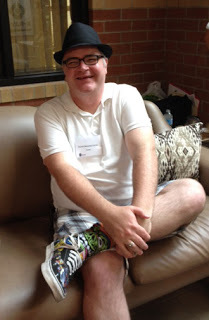 Derek Newman-StilleOrganizers Liz Strange, Barry King, Delina MacDonald and Marlene Smith nailed everything right. Being the first of hopefully many more, this writers’ festival wisely started small. But, like the good Doctor’s tardis, the venue belied its size by being dense with quality and diversity.
Derek Newman-StilleOrganizers Liz Strange, Barry King, Delina MacDonald and Marlene Smith nailed everything right. Being the first of hopefully many more, this writers’ festival wisely started small. But, like the good Doctor’s tardis, the venue belied its size by being dense with quality and diversity.
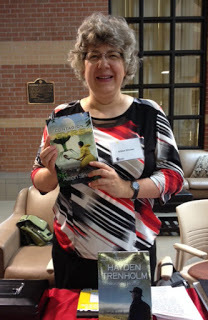 Alison SinclairThe Ongwandada Resource Centre, where the festival was held, had lots of parking with a friendly well-lit ambience inside under an atrium with tables and chairs for gathering and several rooms for panels and workshops.
Alison SinclairThe Ongwandada Resource Centre, where the festival was held, had lots of parking with a friendly well-lit ambience inside under an atrium with tables and chairs for gathering and several rooms for panels and workshops.
.The festival covered several of the major genres such as fantasy, science fiction, horror, romance and mystery, with representation by well-known authors in each. Organizers offered a triple track program from 10 am to 5 pm that included panels, informative workshops, readings, novel pitch sessions with CZP and Bundoran Press and first page critiques with Caro Soles.
.
Festival organizers populated their program with well-established writers from their own communities. Readers of genre fiction and writers looking to learn and network were given the opportunity to meet some of the top genre writers in the region. The venue included a book fair, box lunches and a snack stand. The only thing missing was a primo coffee bar.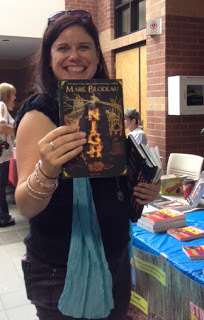 Marie Bilodeau
Marie Bilodeau
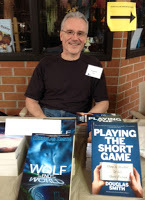 Doug Smith.
Doug Smith.
The small venue provided an intimate setting for great networking. I had a chance to meet many of my old friends and to make new ones. Marie Bilodeau, an Ottawa fantasy writer, gave an exquisite reading of her new series “Nigh”. Alison Sinclair, recently moved to Ottawa, beamed as she showed me the new release of her Eyre series, “Contagion” by Bundoran Press.
Aurora-winning short story author Douglas Smith gave an informative workshop on how to market and sell your short stories. His excellent guidebook “Playing the Short Game” sold for a special festival price. I caught Derek Newman-Stille sitting in the lounge over a box lunch and discussed his radio show in Peterborough and traded stories with Hayden Trenholm, publisher of Bundoran Press and aurora-winning author of the Steeles Chronicles. Other writers who I had a chance to visit with and meet included Caro Soles, Sandra Kasturi (of Chizine), Alyssa Cooper, Eve Langlais, Matt Moore, Nancy Kilpatrick, Matthew Johnson, and Violette Malan.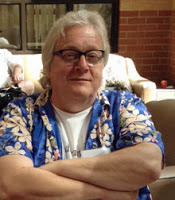 Hayden Trenholm
Hayden Trenholm
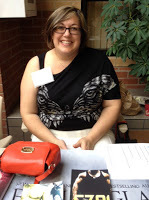 Eve LanglaisThe organizers—themselves published genre writers (Strange writes fantasy, horror and mystery and just released her first science fiction novel, “Erased”; King writes science fiction)—started the festival in response to an observed need to showcase genre writers in the Kingston area, otherwise rich in non-genre writing festivals. “Kingston is in an interesting position because we do have so many writers and we do have the WritersFest and so on,” explained King to Peter Hendra of the Kingston Whig-Standard. King felt there was room to showcase this literature in Kingston and the surrounding area.
Eve LanglaisThe organizers—themselves published genre writers (Strange writes fantasy, horror and mystery and just released her first science fiction novel, “Erased”; King writes science fiction)—started the festival in response to an observed need to showcase genre writers in the Kingston area, otherwise rich in non-genre writing festivals. “Kingston is in an interesting position because we do have so many writers and we do have the WritersFest and so on,” explained King to Peter Hendra of the Kingston Whig-Standard. King felt there was room to showcase this literature in Kingston and the surrounding area.
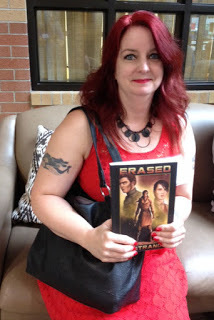 Liz Strange“I find that genre fiction can sometimes be seen on a lower status as ‘literary fiction’, and that stings,” Strange confided to me. “I thought [the LGE] would succeed because there are not that many festivals of this sort, and after we put feelers out to see who might be interested in attending the positive responses were overwhelming.”
Liz Strange“I find that genre fiction can sometimes be seen on a lower status as ‘literary fiction’, and that stings,” Strange confided to me. “I thought [the LGE] would succeed because there are not that many festivals of this sort, and after we put feelers out to see who might be interested in attending the positive responses were overwhelming.”
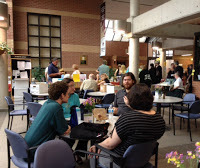
.
Strange added that “nerd culture” these days is more mainstream than in the past, thanks to George R.R. Martin’s Game of Thrones and Stephanie Meyer’s Twilight series. Strange concluded that this is a good thing for writers of romance, sci-fi, horror, mystery and fantasy and observed that genres are blending a lot more (e.g., historical fantasy, paranormal romance, etc.). I personally write mostly blended genres: science fiction thrillers; SF eco-fiction; historical fantasy and romantic SF.
.I asked Strange for her opinion on whether the festival was a success and what the organizers plan to do for next year. She gave a resounding yes; they had double the numbers they’d hoped for and didn’t lose money (a common challenge with writing festivals). With most events tending to be in spring or fall, they chose summer, which worked well and showed off Kingston.
.Based on the feedback and success of the con, it looks like the festival next year will run two days.
.
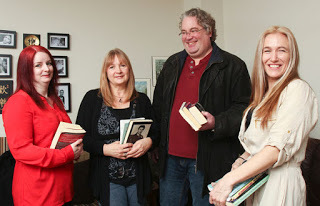 Liz Strange, Marlene Smith, Barry King, Delina MacDonaldNow that’s great news!
Liz Strange, Marlene Smith, Barry King, Delina MacDonaldNow that’s great news!
 Kingston waterfrontKingston, Ontario. The festival gets its name from the city’s moniker, based on the many heritage buildings constructed there using local limestone.
Kingston waterfrontKingston, Ontario. The festival gets its name from the city’s moniker, based on the many heritage buildings constructed there using local limestone..It would have been a very long trip from my digs in Nova Scotia; but I’m currently in Toronto, teaching writing at UofT and George Brown College. I still had to get up earlier than I normally do to get to the 1-day festival that started at ten in the morning.
.It was worth it.
.
 Derek Newman-StilleOrganizers Liz Strange, Barry King, Delina MacDonald and Marlene Smith nailed everything right. Being the first of hopefully many more, this writers’ festival wisely started small. But, like the good Doctor’s tardis, the venue belied its size by being dense with quality and diversity.
Derek Newman-StilleOrganizers Liz Strange, Barry King, Delina MacDonald and Marlene Smith nailed everything right. Being the first of hopefully many more, this writers’ festival wisely started small. But, like the good Doctor’s tardis, the venue belied its size by being dense with quality and diversity.
 Alison SinclairThe Ongwandada Resource Centre, where the festival was held, had lots of parking with a friendly well-lit ambience inside under an atrium with tables and chairs for gathering and several rooms for panels and workshops.
Alison SinclairThe Ongwandada Resource Centre, where the festival was held, had lots of parking with a friendly well-lit ambience inside under an atrium with tables and chairs for gathering and several rooms for panels and workshops. .The festival covered several of the major genres such as fantasy, science fiction, horror, romance and mystery, with representation by well-known authors in each. Organizers offered a triple track program from 10 am to 5 pm that included panels, informative workshops, readings, novel pitch sessions with CZP and Bundoran Press and first page critiques with Caro Soles.
.
Festival organizers populated their program with well-established writers from their own communities. Readers of genre fiction and writers looking to learn and network were given the opportunity to meet some of the top genre writers in the region. The venue included a book fair, box lunches and a snack stand. The only thing missing was a primo coffee bar.
 Marie Bilodeau
Marie Bilodeau
 Doug Smith.
Doug Smith.The small venue provided an intimate setting for great networking. I had a chance to meet many of my old friends and to make new ones. Marie Bilodeau, an Ottawa fantasy writer, gave an exquisite reading of her new series “Nigh”. Alison Sinclair, recently moved to Ottawa, beamed as she showed me the new release of her Eyre series, “Contagion” by Bundoran Press.
Aurora-winning short story author Douglas Smith gave an informative workshop on how to market and sell your short stories. His excellent guidebook “Playing the Short Game” sold for a special festival price. I caught Derek Newman-Stille sitting in the lounge over a box lunch and discussed his radio show in Peterborough and traded stories with Hayden Trenholm, publisher of Bundoran Press and aurora-winning author of the Steeles Chronicles. Other writers who I had a chance to visit with and meet included Caro Soles, Sandra Kasturi (of Chizine), Alyssa Cooper, Eve Langlais, Matt Moore, Nancy Kilpatrick, Matthew Johnson, and Violette Malan.
 Hayden Trenholm
Hayden Trenholm Eve LanglaisThe organizers—themselves published genre writers (Strange writes fantasy, horror and mystery and just released her first science fiction novel, “Erased”; King writes science fiction)—started the festival in response to an observed need to showcase genre writers in the Kingston area, otherwise rich in non-genre writing festivals. “Kingston is in an interesting position because we do have so many writers and we do have the WritersFest and so on,” explained King to Peter Hendra of the Kingston Whig-Standard. King felt there was room to showcase this literature in Kingston and the surrounding area.
Eve LanglaisThe organizers—themselves published genre writers (Strange writes fantasy, horror and mystery and just released her first science fiction novel, “Erased”; King writes science fiction)—started the festival in response to an observed need to showcase genre writers in the Kingston area, otherwise rich in non-genre writing festivals. “Kingston is in an interesting position because we do have so many writers and we do have the WritersFest and so on,” explained King to Peter Hendra of the Kingston Whig-Standard. King felt there was room to showcase this literature in Kingston and the surrounding area.  Liz Strange“I find that genre fiction can sometimes be seen on a lower status as ‘literary fiction’, and that stings,” Strange confided to me. “I thought [the LGE] would succeed because there are not that many festivals of this sort, and after we put feelers out to see who might be interested in attending the positive responses were overwhelming.”
Liz Strange“I find that genre fiction can sometimes be seen on a lower status as ‘literary fiction’, and that stings,” Strange confided to me. “I thought [the LGE] would succeed because there are not that many festivals of this sort, and after we put feelers out to see who might be interested in attending the positive responses were overwhelming.”

.
Strange added that “nerd culture” these days is more mainstream than in the past, thanks to George R.R. Martin’s Game of Thrones and Stephanie Meyer’s Twilight series. Strange concluded that this is a good thing for writers of romance, sci-fi, horror, mystery and fantasy and observed that genres are blending a lot more (e.g., historical fantasy, paranormal romance, etc.). I personally write mostly blended genres: science fiction thrillers; SF eco-fiction; historical fantasy and romantic SF.
.I asked Strange for her opinion on whether the festival was a success and what the organizers plan to do for next year. She gave a resounding yes; they had double the numbers they’d hoped for and didn’t lose money (a common challenge with writing festivals). With most events tending to be in spring or fall, they chose summer, which worked well and showed off Kingston.
.Based on the feedback and success of the con, it looks like the festival next year will run two days.
.
 Liz Strange, Marlene Smith, Barry King, Delina MacDonaldNow that’s great news!
Liz Strange, Marlene Smith, Barry King, Delina MacDonaldNow that’s great news!
Published on August 02, 2015 09:56
June 5, 2015
Submission Call for "My Canada" Anthology
 IOWI has sent out a submission call for its anthology "My Canada", an anthology devoted to stories, poems, articles and images about Canada.
IOWI has sent out a submission call for its anthology "My Canada", an anthology devoted to stories, poems, articles and images about Canada.Deadline: July 30th... EXTENDED TO AUGUST 31st
Submission Guidelines: see the IOWI site
Chief Submission Editor: Nina Munteanu
Contribution Fee: $113; only those accepted for publication are expected to pay the fee, which covers the cost of 10 copies of the anthology.
"My Canada" Anthology
Canada is a vast country of diverse and exciting history, a climate and environment that spans from the boreal forests of the Canadian Shield, muskegs of northern BC, and tundras of the Arctic Circle to the grasslands of the Prairies and southern woodlands of Ontario and Quebec. We live in one of the wealthiest countries in the world, with the 8thhighest per capita income globally, and the 8th highest ranking in the Human Development Index. Canada ranks among the highest in international measurements of government transparency, civil liberties, quality of life, economic freedom, and education. It stands among the world's most educated countries—ranking first worldwide in the number of adults having tertiary education with 51% of adults holding at least an undergraduate college or university degree. With two official languages, Canada has a thriving Aboriginal population and practices an open cultural pluralism, creating a cultural mosaic of racial, religious and cultural practices. Canada’s symbols are influenced by natural, historical and Aboriginal sources. Prominent symbols include the maple leaf, the beaver, Canada Goose, Common Loon, the Royal Canadian Mounted Police, the polar bear, the totem pole, and Inuksuk.The “My Canada” Anthology celebrates this beautiful and wonderful country, from its vast wilderness, great open waters, flat prairies and farm communities to its industry, technology and historical cities.
Call for SubmissionsWe are looking for original, unique works about what it means to live and be in Canada. Works may include one of the following: short story, poetry, creative non-fiction, essay.While the nature of your work may encompass a diversity of expression (e.g., discovery, tragedy, betrayal, endurance, isolation, exploration, transcendence, triumph, humor, inspiration, community) the work needs to portray Canada and being Canadian in a positive light. No Canada-bashing.You may submit on any topic or sub-theme that speaks to being and living in Canada. However, the editors particularly enjoy works that express metaphoric journeys that span Canada’s own diverse ecosystems, particularly the harsher places. Canadian topics we would like to see include:Journey in Nature & WildernessLife in one of Canada’s harsher climatesHistorical discoveries and meanings to selfOvercoming and surviving weather calamity or other natural phenomenon (e.g., ice storms)Traditions of family, friends & communityCanadian city/town phenomenaCanadian activities (e.g., street or ice hockey, skiing, quilting, baking, etc.)Canadian heralds & symbolsArt & photographyMythology, folktales and traditional tales (e.g., Aboriginal stories / experiences; others)Coming to Canada / leaving CanadaTraveling within or outside of CanadaIn all cases, how these observations and experiences affected you philosophically, spiritually, intellectually and viscerally should infuse the work; whether it is a poem, short story or essay, the work should celebrate Canada and being a Canadian. See the specific guidelines below for each narrative form.
Voice and LanguageIn keeping with the multicultural nature of Canada, the intent of this anthology is to fully represent a diversity of writing voices, styles and use of vernacular. The editors reserve the right to reject any work we deem unsuitable for our intended audience. This may include inappropriate subject matter and inappropriate use of expletives or offensive terms. We will not accept any works that promote racism, bigotry, prejudice or other forms of disrespect.
Published on June 05, 2015 15:17
May 10, 2015
Nature Cooperating & Laguna’s Bottlenose Dolphins
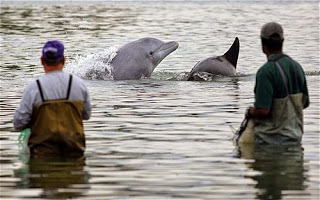 Dolphins helping fishermen catch mulletA few posts back, I discussed the phenomenon called “endosymbiosis” by Dr. Lynn Margulis, who posited a cellular evolution based on ‘cooperation’ rather than simple ‘competition’ between viral or bacterial infection and host cell. This co-evolutionary behaviour runs counter to the traditional route of natural selection and contradicts the ruthless selfishness of Neo-Darwinian thinking. Such an evolving relationship between two different species of life, living together in a very close affinity of mutual benefit is, in fact, common in nature.Co-evolution (and cooperation by default) is now an established theme in the biology of virus-host relationships. Relationships span from the complex interaction between arboviruses and their vector mosquitoes to the one between the malaria-causing plasmodium and humans or the hantavirus and the deer mouse. Virologist, Frank Ryan states that “today...every monkey, baboon, chimpanzee and gorilla is carrying at least ten different species of symbiotic viruses.”
Dolphins helping fishermen catch mulletA few posts back, I discussed the phenomenon called “endosymbiosis” by Dr. Lynn Margulis, who posited a cellular evolution based on ‘cooperation’ rather than simple ‘competition’ between viral or bacterial infection and host cell. This co-evolutionary behaviour runs counter to the traditional route of natural selection and contradicts the ruthless selfishness of Neo-Darwinian thinking. Such an evolving relationship between two different species of life, living together in a very close affinity of mutual benefit is, in fact, common in nature.Co-evolution (and cooperation by default) is now an established theme in the biology of virus-host relationships. Relationships span from the complex interaction between arboviruses and their vector mosquitoes to the one between the malaria-causing plasmodium and humans or the hantavirus and the deer mouse. Virologist, Frank Ryan states that “today...every monkey, baboon, chimpanzee and gorilla is carrying at least ten different species of symbiotic viruses.”Russian biologists, Andrei Famintsyn and Konstantine Merezhkovskii invented the term “symbiogenesis” to explain the fantastic synthesis of new living organisms from symbiotic unions. Citing the evolution of mitochondria and the chloroplast within a primitive host cell to form the more complex eukaryotic cell (as originally theorized by Lynn Margulis), Ryan noted that, “it would be hard to imagine how the step by step gradualism of natural selection could have resulted in this brazenly passionate intercourse of life!” A new science is emerging that recognizes a far more intelligent (and cooperative means) evolution, aptly described by Margulis, "through the long-lasting intimacy of strangers." The fusion of symbiosis followed by natural selection leads to increasingly complex levels of individuality, Margulis suggested. She contended that evolution proceeds through cooperation, not competition: "Life did not take over the globe by combat, but by
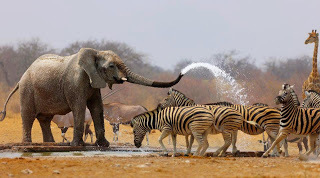 networking."
networking."Examples of such networking, including interspecies cooperation, mutualism and altruism abound in Nature.In Africa birds called ox-peckers perch on the backs of large animals such as giraffes and cattle, and remove insects. The ox-peckers also warn of approaching danger through their cries and disturbed flight. Defenseless fish live unharmed amid the stinging tentacles of jellyfish, and birds such as the wheatear may nest in rabbit burrows. Many flowering plants are pollinated by insects, flitting from flower to flower for their nectar. Some flowers are shaped to suit a particular insect. Seeds are distributed by animals. Birds eat fleshy seeds and transport them. The burrs on plants such as burdock have hooks that may catch on to fur and feathers.
 Enter the dolphin… Perhaps one of the best examples of interspecies cooperation (or mutualism and altruism). In 2008 Aubrey Manning (Emeritus Professor of Natural History at Edinburgh University) wrote in the Daily Mail of a female dolphin who selflessly saved a beached mother whale and her calf off Mahia Beach in New Zealand. The bottlenose dolphins off Laguna in Brazil have developed a cooperative relationship with the local fishermen… "Through highly synchronized behavior with humans, cooperative dolphins in Laguna drive mullet schools towards a line of fishermen and 'signal,' via stereotyped head slaps or tail slaps, when and where fishermen should throw their nets," wrote lead author Fabio Daura-Jorge of the Federal University of Santa Catarina. The cooperation is helpful to both parties, he said.New research has found that one local group of about 20 dolphins works with the fishermen, while other local dolphins don't cooperate, finding other sources of food. A study published in the latest Royal Society Biology Letters found that the most helpful ones are also particularly cooperative and social with each other.
Enter the dolphin… Perhaps one of the best examples of interspecies cooperation (or mutualism and altruism). In 2008 Aubrey Manning (Emeritus Professor of Natural History at Edinburgh University) wrote in the Daily Mail of a female dolphin who selflessly saved a beached mother whale and her calf off Mahia Beach in New Zealand. The bottlenose dolphins off Laguna in Brazil have developed a cooperative relationship with the local fishermen… "Through highly synchronized behavior with humans, cooperative dolphins in Laguna drive mullet schools towards a line of fishermen and 'signal,' via stereotyped head slaps or tail slaps, when and where fishermen should throw their nets," wrote lead author Fabio Daura-Jorge of the Federal University of Santa Catarina. The cooperation is helpful to both parties, he said.New research has found that one local group of about 20 dolphins works with the fishermen, while other local dolphins don't cooperate, finding other sources of food. A study published in the latest Royal Society Biology Letters found that the most helpful ones are also particularly cooperative and social with each other.
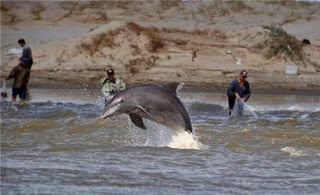 Dolphins help fishermen catch mulletAbout 200 local artisanal fishermen are almost entirely reliant on the dolphins for catching their fish," Daura-Jorge wrote. The fishermen only fish with the assistance of cooperative dolphins, recognized and named.
Dolphins help fishermen catch mulletAbout 200 local artisanal fishermen are almost entirely reliant on the dolphins for catching their fish," Daura-Jorge wrote. The fishermen only fish with the assistance of cooperative dolphins, recognized and named. The cooperation behavior may be passed down from mother dolphin to her calves through social learning, reflecting how the trait is passed down by the fishermen: Elders in the community teach the younger fishermen how to work with the dolphins.
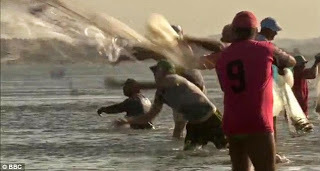 We tend to exclude the rest of animal and plant life from exhibiting the highest form of intelligence: that of cooperation and altruism. Many of us—if we even accept the existence of true altruism—consider it an exclusively human quality. This is a hubristic remnant of a “conquest” mentality in which humanity identifies itself as separate from Nature. It blinds us from a reality that lies right before us. We cannot see what we don’t look for; we can’t know what we don’t believe.
We tend to exclude the rest of animal and plant life from exhibiting the highest form of intelligence: that of cooperation and altruism. Many of us—if we even accept the existence of true altruism—consider it an exclusively human quality. This is a hubristic remnant of a “conquest” mentality in which humanity identifies itself as separate from Nature. It blinds us from a reality that lies right before us. We cannot see what we don’t look for; we can’t know what we don’t believe. We rely on science to answer questions we already “know” the answers to, because we have lost a sense of Unity. And as Goethe said of conventional scientists, “Whatever you cannot calculate, you do not think is real.”
Richard Tarnas, author of The Passion of the Western Mind posits that the evolution of the Western mind has been driven by a “heroic impulse to forge an autonomous rational human self—a transforming self—by separating it from the primordial unity with nature.” Tarnas suggests that it began four millennia ago, with the great patriarchal nomadic conquests in the Mediterranean. Conquests that embraced “the repression of undifferentiated unitary consciousness and the participation mystique with nature; a denial of the anima mundi, of the soul of the world, of the community of being, of the all-pervading, of mystery and ambiguity, of imagination, emotion, instinct, body, nature, woman.”Goethe and others like him believed that the human mind is ultimately the organ of the world’s own process of self-revelation. In this view, Nature is not a separate, independent self-contained reality to be ‘objectively’ examined by humanity from without; rather, its unfolding truth emerges only with the active participation of the human mind. It is something that comes into being through the very act of human cognition.
Related Posts:Co-evolution: cooperation & aggressive symbiosisWhat Altruism in Animals can Teach Us About OurselvesMargaret Atwood’s Wise Words About Debt & Altruism…”A Portrait of the Artist as a Real Hero”Is James Bond an Altruist?Gaia vs. Medea: A Case for AltruismRupert Sheldrake and the Physics of AngelsThe Gaia HypothesisSpiritual Ecology and the Lesson of Crete
Choosing the Less Worn Path of Intuition
Published on May 10, 2015 21:23
April 10, 2015
Mass Intelligent TV and the Age of the Disposable Hero--Valar Morghulis
 The word out there—at least according to The Economist Group—is that “smart is the new cool”. John Parker of Intelligent Life (sister magazine to The Economist) posits that, “in its appetite for culture, the world is wising up more than it is dumbing down.” Parker suggests in his article “The Age of Mass Intelligence” (Intelligent Life, 2008) that this apparent increase in the “mass intelligent” can be seen in the growing appeal of museums, blockbuster exhibitions, literary festivals, and operas. What he fails to mention is how the increased sales of good literature translate into actual reading and synthesis. According to Susan Jacoby, scholar and author of The Age of American Unreason, Parker’s article exemplifies a culture-as-commodity perspective: “If we are going to more literary festivals graced with celebrities and greased with abundant alcohol, if we are spending freely in the museum shops of world capitals and if we are willing to give Anna Kareninaa try because Oprah Winfrey has conferred her imprimatur on Tolstoy and his doomed heroine, why, we must be getting smarter.” Ultimately, adds Jacoby, “It is not a question of whether people read Dickens and Tolstoy, as opposed to Dan Brown and Barbara Cartland, but whether they read anything longer than the text bites that constitute "reading" on the web. I place the word in quotation marks because most of us are engaged online not in uninterrupted traditional reading but in a vulture-like swoop to gather tidbits of information.” Jacoby describes Parker’s phrase, “appetite for culture”, as not only allegorical but as symptomatic of a growing culture of addictions. Culture commoditized; something to be consumed, digested and excreted as opposed to experienced, processed and enlightened by.
The word out there—at least according to The Economist Group—is that “smart is the new cool”. John Parker of Intelligent Life (sister magazine to The Economist) posits that, “in its appetite for culture, the world is wising up more than it is dumbing down.” Parker suggests in his article “The Age of Mass Intelligence” (Intelligent Life, 2008) that this apparent increase in the “mass intelligent” can be seen in the growing appeal of museums, blockbuster exhibitions, literary festivals, and operas. What he fails to mention is how the increased sales of good literature translate into actual reading and synthesis. According to Susan Jacoby, scholar and author of The Age of American Unreason, Parker’s article exemplifies a culture-as-commodity perspective: “If we are going to more literary festivals graced with celebrities and greased with abundant alcohol, if we are spending freely in the museum shops of world capitals and if we are willing to give Anna Kareninaa try because Oprah Winfrey has conferred her imprimatur on Tolstoy and his doomed heroine, why, we must be getting smarter.” Ultimately, adds Jacoby, “It is not a question of whether people read Dickens and Tolstoy, as opposed to Dan Brown and Barbara Cartland, but whether they read anything longer than the text bites that constitute "reading" on the web. I place the word in quotation marks because most of us are engaged online not in uninterrupted traditional reading but in a vulture-like swoop to gather tidbits of information.” Jacoby describes Parker’s phrase, “appetite for culture”, as not only allegorical but as symptomatic of a growing culture of addictions. Culture commoditized; something to be consumed, digested and excreted as opposed to experienced, processed and enlightened by. “The defining phenomenon of our society during the past three decades has been the triumph of video over print culture in general, and of shorter blocks of text over longer, reflective articles. This process began in old-fashioned print media and has reached its apotheosis on the Internet,” says Jacoby.Evidence undeniably shows that more people are being exposed to aspects of culture. Computers and now smartphones have created an “instantly accessible” information-rich society. Eighty-five percent of young adults are smartphone owners, who use their mobile devices in a host of information seeking and transaction. A majority of smartphone owners use their phone to follow breaking news and share local events—as they happen. Buckminster Fuller observed that human knowledge doubled every century until 1900; by the end of World War II it was doubling every 25 years. It now doubles every 13 months. Does this reflect a genuine rise in “mass intelligence” or does it simply demonstrate better marketing and an improvement by society in absorbing packaged information?
“The defining phenomenon of our society during the past three decades has been the triumph of video over print culture in general, and of shorter blocks of text over longer, reflective articles. This process began in old-fashioned print media and has reached its apotheosis on the Internet,” says Jacoby.Evidence undeniably shows that more people are being exposed to aspects of culture. Computers and now smartphones have created an “instantly accessible” information-rich society. Eighty-five percent of young adults are smartphone owners, who use their mobile devices in a host of information seeking and transaction. A majority of smartphone owners use their phone to follow breaking news and share local events—as they happen. Buckminster Fuller observed that human knowledge doubled every century until 1900; by the end of World War II it was doubling every 25 years. It now doubles every 13 months. Does this reflect a genuine rise in “mass intelligence” or does it simply demonstrate better marketing and an improvement by society in absorbing packaged information? Mass Intelligent TV and the Age of the Disposable Hero (with apologies to those of you who
 currently enjoy Game of Thrones)
currently enjoy Game of Thrones)Like a gestalt barometer of a culture, the story narrative reflects upon and expresses humanity’s artistic soul. The stories of a culture convey its values and qualities. And, ultimately, they carry a culture through its own evolution. Emily Gardner of the Economist Group contends that HBO’s immensely popular medieval fantasy Game of Thrones, with its complex character plotlines, intrigue, and elegant world-building, exemplifies a rising “mass intelligent”, coined by Economist CEO Andrew Rashbass to describe a rise in the ‘nerdy’, smarter more discerning TV viewer. Granted, the TV series, based on George R.R. Martin’s fantasy/horror book series A Song of Ice and Fire, contains intelligent characters with depth (superbly played by an accomplished cast), and some of the best world-building ever shown on TV. However, Game of Thrones also drowns these with copious graphic scenes of mutilations, dismemberments, flailing, crucifixions, castrations, beheadings and random axes in heads—not to mention ceremonious displays of these various parts. The script, though intelligent at times, is fraught with misanthropic voyeurism that borders on sociopathic. Heroes and villains alike are unceremoniously tortured, flayed alive, dismembered and worse—with no recourse for transcendence or redemption. The producers defend the graphic brutality of Game of Thrones with the assertion that it is not a Disneyesque fairytale version of the world; rather, they meant to capture the gritty reality of the world. however, as Internet commenter Todd Geist wrote, “Game of Thrones is very compelling. But so is a train wreck.”Good fiction—unlike a reality show—tells a purposeful story with fictional characters who play a purposeful role—usually in a journey of change and a story arc based on a meaningful theme. This doesn’t have to entail a happy ending, but it does include meaning and fulfillment—even if only for its audience. Without a meaningful arc, a character (and its empathizing viewer) remains unfulfilled. When too many heroic characters are subjected to such an abrupt ending (with their arc unfulfilled), the viewer will distrust the narrative and distance herself. Reluctant to invest in any heroic character, she becomes less story-participant and more distant-onlooker. The narrative arc, once collapsed, naturally gives way to the thrill-seeking pattern of the addict, anticipating the next thrill. Moreover, when theme-carrying characters fail to prevail, this puts into question the very theme they carry, further disassociating the viewer. This is best represented by the Stark family of Winterfell, who are all but destroyed by the second season of the show.
 According to Tom Gualtieri of Salon, in the land of Westeros naivety is punished and cunning is more valuable than honor. “The Red Wedding, like so much that happens to the Starks, makes integrity seem like naiveté,” says Gualtieri. “The Starks’ belief in honor is a noble trait which impairs their judgment, blinding them to the treachery of others.” Gualtieri’s cynical assessment demonstrates how Game of Thrones has strayed from its initial story promise by making its theme-carrying heroes disposable.With Season Five of Game of Thrones poised to simulcast to 170 countries on April 12, news feeds scramble with teasers to whet the unruly addiction of fans, gripped by the frenzy of the “game”.Game of Thrones may indeed epitomize the concept of a rising “mass intelligence” with its intriguing, compact bite-sized subplots and disposable heroes. The “mass intelligent” culture prizes information over understanding and knowledge over wisdom. We empower our smartphones with an attention we fail to bestow on our friends. We are a sensory-deprived culture, addicted to piece-meal thrills and sensationalism to carry us through our otherwise meaningless days. We obsess over but dare not empathize with the disposable heroes of our stories. Our TV programs increasingly feature the gritty anti-hero (or even villain) as main protagonist. A growing discussion among those who study story challenges the Jungian-Campbell archetypal narrative of change and transcendence and favors alternative plot structures with no hero, no goals, and no achievement. “Reality shows” and fiction narrative increasingly blur as we enter the ‘zero narrative’ “Age of Mass Intelligence”.
According to Tom Gualtieri of Salon, in the land of Westeros naivety is punished and cunning is more valuable than honor. “The Red Wedding, like so much that happens to the Starks, makes integrity seem like naiveté,” says Gualtieri. “The Starks’ belief in honor is a noble trait which impairs their judgment, blinding them to the treachery of others.” Gualtieri’s cynical assessment demonstrates how Game of Thrones has strayed from its initial story promise by making its theme-carrying heroes disposable.With Season Five of Game of Thrones poised to simulcast to 170 countries on April 12, news feeds scramble with teasers to whet the unruly addiction of fans, gripped by the frenzy of the “game”.Game of Thrones may indeed epitomize the concept of a rising “mass intelligence” with its intriguing, compact bite-sized subplots and disposable heroes. The “mass intelligent” culture prizes information over understanding and knowledge over wisdom. We empower our smartphones with an attention we fail to bestow on our friends. We are a sensory-deprived culture, addicted to piece-meal thrills and sensationalism to carry us through our otherwise meaningless days. We obsess over but dare not empathize with the disposable heroes of our stories. Our TV programs increasingly feature the gritty anti-hero (or even villain) as main protagonist. A growing discussion among those who study story challenges the Jungian-Campbell archetypal narrative of change and transcendence and favors alternative plot structures with no hero, no goals, and no achievement. “Reality shows” and fiction narrative increasingly blur as we enter the ‘zero narrative’ “Age of Mass Intelligence”. The hero is dead, long live the hero!
 Nina Munteanu
is an ecologist and internationally published author of novels, short stories and essays. She coaches writers and teaches writing at George Brown College and the University of Toronto. For more about Nina’s coaching & workshops visit
www.ninamunteanu.me
. Visit
www.ninamunteanu.ca
for more about her writing.
Nina Munteanu
is an ecologist and internationally published author of novels, short stories and essays. She coaches writers and teaches writing at George Brown College and the University of Toronto. For more about Nina’s coaching & workshops visit
www.ninamunteanu.me
. Visit
www.ninamunteanu.ca
for more about her writing.
Published on April 10, 2015 20:48
The Story Is Dead, Long Live The Story!
 The word out there—at least according to The Economist Group—is that “smart is the new cool”. John Parker of Intelligent Life (sister magazine to The Economist) posits that, “in its appetite for culture, the world is wising up more than it is dumbing down.” Parker suggests in his article “The Age of Mass Intelligence” (Intelligent Life, 2008) that this apparent increase in the “mass intelligent” can be seen in the growing appeal of museums, blockbuster exhibitions, literary festivals, and operas. What he fails to mention is how the increased sales of good literature translate into actual reading and synthesis. According to Susan Jacoby, scholar and author of The Age of American Unreason, Parker’s article exemplifies a culture-as-commodity perspective: “If we are going to more literary festivals graced with celebrities and greased with abundant alcohol, if we are spending freely in the museum shops of world capitals and if we are willing to give Anna Kareninaa try because Oprah Winfrey has conferred her imprimatur on Tolstoy and his doomed heroine, why, we must be getting smarter.” Ultimately, adds Jacoby, “It is not a question of whether people read Dickens and Tolstoy, as opposed to Dan Brown and Barbara Cartland, but whether they read anything longer than the text bites that constitute "reading" on the web. I place the word in quotation marks because most of us are engaged online not in uninterrupted traditional reading but in a vulture-like swoop to gather tidbits of information.” Jacoby describes Parker’s phrase, “appetite for culture”, as not only allegorical but as symptomatic of a growing culture of addictions. Culture commoditized; something to be consumed, digested and excreted as opposed to experienced, processed and enlightened by.
The word out there—at least according to The Economist Group—is that “smart is the new cool”. John Parker of Intelligent Life (sister magazine to The Economist) posits that, “in its appetite for culture, the world is wising up more than it is dumbing down.” Parker suggests in his article “The Age of Mass Intelligence” (Intelligent Life, 2008) that this apparent increase in the “mass intelligent” can be seen in the growing appeal of museums, blockbuster exhibitions, literary festivals, and operas. What he fails to mention is how the increased sales of good literature translate into actual reading and synthesis. According to Susan Jacoby, scholar and author of The Age of American Unreason, Parker’s article exemplifies a culture-as-commodity perspective: “If we are going to more literary festivals graced with celebrities and greased with abundant alcohol, if we are spending freely in the museum shops of world capitals and if we are willing to give Anna Kareninaa try because Oprah Winfrey has conferred her imprimatur on Tolstoy and his doomed heroine, why, we must be getting smarter.” Ultimately, adds Jacoby, “It is not a question of whether people read Dickens and Tolstoy, as opposed to Dan Brown and Barbara Cartland, but whether they read anything longer than the text bites that constitute "reading" on the web. I place the word in quotation marks because most of us are engaged online not in uninterrupted traditional reading but in a vulture-like swoop to gather tidbits of information.” Jacoby describes Parker’s phrase, “appetite for culture”, as not only allegorical but as symptomatic of a growing culture of addictions. Culture commoditized; something to be consumed, digested and excreted as opposed to experienced, processed and enlightened by. “The defining phenomenon of our society during the past three decades has been the triumph of video over print culture in general, and of shorter blocks of text over longer, reflective articles. This process began in old-fashioned print media and has reached its apotheosis on the Internet,” says Jacoby.Evidence undeniably shows that more people are being exposed to aspects of culture. Computers and now smartphones have created an “instantly accessible” information-rich society. Eighty-five percent of young adults are smartphone owners, who use their mobile devices in a host of information seeking and transaction. A majority of smartphone owners use their phone to follow breaking news and share local events—as they happen. Buckminster Fuller observed that human knowledge doubled every century until 1900; by the end of World War II it was doubling every 25 years. It now doubles every 13 months. Does this reflect a genuine rise in “mass intelligence” or does it simply demonstrate better marketing and an improvement by society in absorbing packaged information?
“The defining phenomenon of our society during the past three decades has been the triumph of video over print culture in general, and of shorter blocks of text over longer, reflective articles. This process began in old-fashioned print media and has reached its apotheosis on the Internet,” says Jacoby.Evidence undeniably shows that more people are being exposed to aspects of culture. Computers and now smartphones have created an “instantly accessible” information-rich society. Eighty-five percent of young adults are smartphone owners, who use their mobile devices in a host of information seeking and transaction. A majority of smartphone owners use their phone to follow breaking news and share local events—as they happen. Buckminster Fuller observed that human knowledge doubled every century until 1900; by the end of World War II it was doubling every 25 years. It now doubles every 13 months. Does this reflect a genuine rise in “mass intelligence” or does it simply demonstrate better marketing and an improvement by society in absorbing packaged information? Mass Intelligent TV and the Age of the Disposable Hero (with apologies to those of you who
 currently enjoy Game of Thrones)
currently enjoy Game of Thrones)Like a gestalt barometer of a culture, the story narrative reflects upon and expresses humanity’s artistic soul. The stories of a culture convey its values and qualities. And, ultimately, they carry a culture through its own evolution. Emily Gardner of the Economist Group contends that HBO’s immensely popular medieval fantasy Game of Thrones, with its complex character plotlines, intrigue, and elegant world-building, exemplifies a rising “mass intelligent”, coined by Economist CEO Andrew Rashbass to describe a rise in the ‘nerdy’, smarter more discerning TV viewer. Granted, the TV series, based on George R.R. Martin’s fantasy/horror book series A Song of Ice and Fire, contains intelligent characters with depth (superbly played by an accomplished cast), and some of the best world-building ever shown on TV. However, Game of Thrones also drowns these with copious graphic scenes of mutilations, dismemberments, flailing, crucifixions, castrations, beheadings and random axes in heads—not to mention ceremonious displays of these various parts. The script, though intelligent at times, is fraught with misanthropic voyeurism that borders on sociopathic. Heroes and villains alike are unceremoniously tortured, flayed alive, dismembered and worse—with no recourse for transcendence or redemption. The producers defend the graphic brutality of Game of Thrones with the assertion that it is not a Disneyesque fairytale version of the world; rather, they meant to capture the gritty reality of the world. however, as Internet commenter Todd Geist wrote, “Game of Thrones is very compelling. But so is a train wreck.”Good fiction—unlike a reality show—tells a purposeful story with fictional characters who play a purposeful role—usually in a journey of change and a story arc based on a meaningful theme. This doesn’t have to entail a happy ending, but it does include meaning and fulfillment—even if only for its audience. Without a meaningful arc, a character (and its empathizing viewer) remains unfulfilled. When too many heroic characters are subjected to such an abrupt ending (with their arc unfulfilled), the viewer will distrust the narrative and distance herself. Reluctant to invest in any heroic character, she becomes less story-participant and more distant-onlooker. The narrative arc, once collapsed, naturally gives way to the thrill-seeking pattern of the addict, anticipating the next thrill. Moreover, when theme-carrying characters fail to prevail, this puts into question the very theme they carry, further disassociating the viewer. This is best represented by the Stark family of Winterfell, who are all but destroyed by the second season of the show.
 According to Tom Gualtieri of Salon, in the land of Westeros naivety is punished and cunning is more valuable than honor. “The Red Wedding, like so much that happens to the Starks, makes integrity seem like naiveté,” says Gualtieri. “The Starks’ belief in honor is a noble trait which impairs their judgment, blinding them to the treachery of others.” Gualtieri’s cynical assessment demonstrates how Game of Thrones has strayed from its initial story promise by making its theme-carrying heroes disposable.With Season Five of Game of Thrones poised to simulcast to 170 countries on April 12, news feeds scramble with teasers to whet the unruly addiction of fans, gripped by the frenzy of the “game”.Game of Thrones may indeed epitomize the concept of a rising “mass intelligence” with its intriguing, compact bite-sized subplots and disposable heroes. The “mass intelligent” culture prizes information over understanding and knowledge over wisdom. We empower our smartphones with an attention we fail to bestow on our friends. We are a sensory-deprived culture, addicted to piece-meal thrills and sensationalism to carry us through our otherwise meaningless days. We obsess over but dare not empathize with the disposable heroes of our stories. Our TV programs increasingly feature the gritty anti-hero (or even villain) as main protagonist. A growing discussion among those who study story challenges the Jungian-Campbell archetypal narrative of change and transcendence and favors alternative plot structures with no hero, no goals, and no achievement. “Reality shows” and fiction narrative increasingly blur as we enter the ‘zero narrative’ “Age of Mass Intelligence”.
According to Tom Gualtieri of Salon, in the land of Westeros naivety is punished and cunning is more valuable than honor. “The Red Wedding, like so much that happens to the Starks, makes integrity seem like naiveté,” says Gualtieri. “The Starks’ belief in honor is a noble trait which impairs their judgment, blinding them to the treachery of others.” Gualtieri’s cynical assessment demonstrates how Game of Thrones has strayed from its initial story promise by making its theme-carrying heroes disposable.With Season Five of Game of Thrones poised to simulcast to 170 countries on April 12, news feeds scramble with teasers to whet the unruly addiction of fans, gripped by the frenzy of the “game”.Game of Thrones may indeed epitomize the concept of a rising “mass intelligence” with its intriguing, compact bite-sized subplots and disposable heroes. The “mass intelligent” culture prizes information over understanding and knowledge over wisdom. We empower our smartphones with an attention we fail to bestow on our friends. We are a sensory-deprived culture, addicted to piece-meal thrills and sensationalism to carry us through our otherwise meaningless days. We obsess over but dare not empathize with the disposable heroes of our stories. Our TV programs increasingly feature the gritty anti-hero (or even villain) as main protagonist. A growing discussion among those who study story challenges the Jungian-Campbell archetypal narrative of change and transcendence and favors alternative plot structures with no hero, no goals, and no achievement. “Reality shows” and fiction narrative increasingly blur as we enter the ‘zero narrative’ “Age of Mass Intelligence”. The hero is dead, long live the hero!
 Nina Munteanu
is an ecologist and internationally published author of novels, short stories and essays. She coaches writers and teaches writing at George Brown College and the University of Toronto. For more about Nina’s coaching & workshops visit
www.ninamunteanu.me
. Visit
www.ninamunteanu.ca
for more about her writing.
Nina Munteanu
is an ecologist and internationally published author of novels, short stories and essays. She coaches writers and teaches writing at George Brown College and the University of Toronto. For more about Nina’s coaching & workshops visit
www.ninamunteanu.me
. Visit
www.ninamunteanu.ca
for more about her writing.
Published on April 10, 2015 20:48
March 28, 2015
Nina Teaching SF Writing Course at George Brown College Spring 2015
I'm back at George Brown College, teaching my 12-week long writing course on how to write science fiction. "Creating Science Fiction" is now part of George Brown's Creative Writing Certificate.
The course starts April and runs until June-end.

Called “Creating Science Fiction”, the course runs Wednesday nights from 6:15 to 9:15 starting September 17 through to December 3 and costs $278.Meant for both beginning writers and those already published, the 12-week course is run like a workshop with student input and feedback on student’s WIPs. Munteanu explores with students the essential tools used in the SF genre (including world building, research and plot approaches). “Students will work toward a publishable original piece by learning to generate and follow through with premise, idea and theme,” says Munteanu.
You can register for the course here: http://coned.georgebrown.ca/owa_prod/cewskcrss.P_CrseGet?subj_code=LIBA&crse_numb=9351George Brown College is located on 200 King Street, Toronto, Canada.
The course starts April and runs until June-end.

Called “Creating Science Fiction”, the course runs Wednesday nights from 6:15 to 9:15 starting September 17 through to December 3 and costs $278.Meant for both beginning writers and those already published, the 12-week course is run like a workshop with student input and feedback on student’s WIPs. Munteanu explores with students the essential tools used in the SF genre (including world building, research and plot approaches). “Students will work toward a publishable original piece by learning to generate and follow through with premise, idea and theme,” says Munteanu.
You can register for the course here: http://coned.georgebrown.ca/owa_prod/cewskcrss.P_CrseGet?subj_code=LIBA&crse_numb=9351George Brown College is located on 200 King Street, Toronto, Canada.
Published on March 28, 2015 17:32
March 8, 2015
Interview with Nina Munteanu on Fantasy Fiction Focus with Simon Rose
I participated recently in an interview with Simon Rose, author and host of Fantasy Fiction Focus, in which we discussed eco-fiction, emerging trends in science fiction, the changing publishing industry, and what it all means for new writers...like how to promote yourself and your book, branding, and other aspects of being a writer
Published on March 08, 2015 21:34
February 22, 2015
Nina Talks to EAC on the Changing Face of Publishing
Some time ago, I gave a talk on the changing face of publishing and writing for editors at EAC in Toronto.
Published on February 22, 2015 14:18
February 7, 2015
Hubble Captures Jupiter’s Great Entourage of Moons
 Jupiter and its Entourage of MoonsIn anticipation of watching the new release of the science fiction/fantasy thriller Jupiter Ascending this weekend, I ran across this recent February 7 2015 article on
Bad Astronomy
, by author and astronomer Phil Plait.
Jupiter and its Entourage of MoonsIn anticipation of watching the new release of the science fiction/fantasy thriller Jupiter Ascending this weekend, I ran across this recent February 7 2015 article on
Bad Astronomy
, by author and astronomer Phil Plait.Jupiter is approaching opposition (when it’s opposite in the sky from the Sun), which means it’s as close to Earth as it gets for the year, Plait tells us. So, now is the time to observe it! Of course; I get two Jupiters in one month! In his article Plait gives good instructions on how to find and watch Jupiter (the planet, that is) if you have a telescope or even binoculars.
On January 24, 2015, says Plait, three of Jupiter’s largest moons crossed directly in front of Jupiter’s face at the same time. “This is called a triple transit, and it’s a relatively rare event,” writes Plait. Of course, the Hubble Space Telescope was there to take the most awesome shots of this phenomenon.
The image depicted here clearly shows the yellowish volcanic Io in the upper right. Europa is on the
 Jupiter Ascending motion picturelower left and Callisto to its upper right (Ganymede, the fourth of the larger moons, is not in the picture). The moons’ shadows are clearly cast on Jupiter’s massive streaked face of swirling hydrogen, helium, methane, water vapor, ammonia and silicon-based compounds. Traces of carbon, ethane, hydrogen sulfide, neon, oxygen, phosphine and sulfur, benzene, and hydrocarbons exist in Jupiter’s atmosphere. Its outermost layer contains frozen ammonia crystals.
Jupiter Ascending motion picturelower left and Callisto to its upper right (Ganymede, the fourth of the larger moons, is not in the picture). The moons’ shadows are clearly cast on Jupiter’s massive streaked face of swirling hydrogen, helium, methane, water vapor, ammonia and silicon-based compounds. Traces of carbon, ethane, hydrogen sulfide, neon, oxygen, phosphine and sulfur, benzene, and hydrocarbons exist in Jupiter’s atmosphere. Its outermost layer contains frozen ammonia crystals. Plait explains how studying the positions of the shadows shows the relative orbital distances of the moons around Jupiter. Europa with its ice-covered liquid ocean, for instance has a much closer orbit to Jupiter than Callisto.
 Jupiter's turbulent storms seen from Voyager 1The dark belts and light streaks of Jupiter are a spinning highway of turbulent atmospheric gases circling the planet in opposite directions. You can see the turbulent swirling vortices at their boundaries, where the to and fro meet.
Jupiter's turbulent storms seen from Voyager 1The dark belts and light streaks of Jupiter are a spinning highway of turbulent atmospheric gases circling the planet in opposite directions. You can see the turbulent swirling vortices at their boundaries, where the to and fro meet.Plait shows a spectacular video of the triple transit over Jupiter’s spinning face. Jupiter’s rotation is the fastest of all the Solar System’s planets, taking less than 10 hours for this gas giant to spin once. Plait noted the different orbiting speeds of Europa’s rapid and Callisto’s more languid orbits.
Jupiter has dozens of moons; thirty seven discovered so far. Astronomers have classified them into two major groups: the regular moons with nearly circular orbits near the plane of Jupiter (believed to have formed with Jupiter); and irregular moons with elliptical and inclined orbits (believed to be captured asteroids or their fragments). Hubble’s video captured two of these lumpy rocks. One, called Amalthea, is about 250 km along its long axis. Thebe is about 100 km across. Amalthea was the first moon of Jupiter discovered since Galileo spotted the big four; it was found in 1892. Thebe was discovered when Voyager 1 flew past it in 1979.
In a few days, after I’ve seen the film, I’ll let you know which “Jupiter” is more fascinating.
 Nina Munteanu
is an ecologist and internationally published author of novels, short stories and essays. She coaches writers and teaches writing at George Brown College and the University of Toronto. For more about Nina’s coaching & workshops visit
www.ninamunteanu.me
. Visit
www.ninamunteanu.ca
for more about her writing.
Nina Munteanu
is an ecologist and internationally published author of novels, short stories and essays. She coaches writers and teaches writing at George Brown College and the University of Toronto. For more about Nina’s coaching & workshops visit
www.ninamunteanu.me
. Visit
www.ninamunteanu.ca
for more about her writing.
Published on February 07, 2015 10:33
February 2, 2015
Reader Shares Favourite Passage in Darwin's Paradox
When Monique wrote me to tell me how she had enjoyed my SF thriller
Darwin's Paradox
, set in post climate-change Ontario Canada, I was delighted. But she did more; she included her favourite passage! Here it is from Page 68:

"For me," said Monique, "this captures the beauty of the science underlying our humanity .... or our humanity underlying the science."
Thanks so much for sharing this, Monique!
Nina Munteanu is an ecologist and internationally published author of novels, short stories and essays. She coaches writers and teaches writing at George Brown College and the University of Toronto. For more about Nina’s coaching & workshops visit www.ninamunteanu.me . Visit www.ninamunteanu.ca for more about her writing.

As the laminar flow spilled into riotous tendrils only to find a uniform pattern of turbulence, she was once again reminded of her father and chaos theory. Stable chaos, he insisted, permeated everything and everyone. Like fractals of a larger interconnected universe, each person had his or her own cycle of creative destruction to experience before merging into a greater community of consciousness. Where was she in that cycle? Would she be as serene when it was her time like her father was the day the Pols took him?
"For me," said Monique, "this captures the beauty of the science underlying our humanity .... or our humanity underlying the science."
Thanks so much for sharing this, Monique!
Nina Munteanu is an ecologist and internationally published author of novels, short stories and essays. She coaches writers and teaches writing at George Brown College and the University of Toronto. For more about Nina’s coaching & workshops visit www.ninamunteanu.me . Visit www.ninamunteanu.ca for more about her writing.
Published on February 02, 2015 21:14



